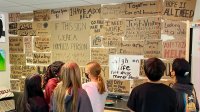Poverty and Homelessness in Schools
This week, we’re discussing homelessness and poverty, two urgent issues that have an impact on people all across the world. Due to their inability to pay for an education for a variety of reasons, this problem has gotten so bad in the US that it is now having an impact on how kids learn. The annual count of homeless kids identified by public schools has risen by over 100% since 2008, rising from roughly 680,000 to 1,384,000 children in 2019 according to the NSBA (Cai, 2020) and according to the National Center for Homeless Education (2022), 2.2% of students in public schools were homeless in the 2020-2021 school year. This week’s module addresses a number of topics, including how, despite public education being free for all US citizens, districts may choose to overlook the needs of their kids in order to save money. Another recurring topic was the possibility that students who experience poverty can feel embarrassed about their circumstances since it keeps them from experiencing college life, and in certain situations, it might even lead to bullying. Personally I think that we don’t draw as much attention to this subject because there is such topics such as bullying, gun control or even mental health disorders but this is just as significant because children’s right to education is taken from them.

Getty Images. gettyimages.com. Accessed 2 Mar. 2024.
According to the documentary “The Homestretch,” adolescents who are impoverished frequently experience shame because they feel alone and alone in educational environments due to a lack of resources (Bullfrog Films, 2014). Due to their financial difficulties, they frequently cannot afford school lunches, school supplies, school trips, or even technology to stay in touch with classmates and teachers. Bullying also occurs in schools, when some students find it acceptable to make fun of others for not being able to buy specific items like clothing, vacations, accessories, technology, etc. Due to the shame of not being able to buy even a school meal every day and the fear of being teased, students living in poverty often keep their concerns hidden, which worsens their mental health. As we have talked about in the past, bullying is not ok in any way shape or form. In my future classroom there will be a zero tolerance policy in placed to prevent bullying happen in general. If I come across a student in need of extra nurture I would ensure food, clothing, shelter, healthcare, basic hygiene, and transportation needs are met. Give the family or student a list of local resources. Locate a location where students can take a shower if needed. Lastly, have nutritious food on hand at all times.
Without the resources necessary for a quality education, how are young people expected to choose occupations that will provide for them in the future? The priorities of this nation need to be clarified. According to The Center for Public Integrity, equal access to educational opportunities, including public preschool education, should be granted to children who are homeless. Schools are required by federal law to remove any obstacles that might make that impossible (Mitchell, 2022). So why would school districts deny students of these rights? How come we don’t want to educate the future of our society? It amazes me that people could be this neglectful and it pains me that we aren’t taking as much action as we should be. It’s time to make a change in those school districts that seem to “forget” that these laws exist. As a future educator I am determined to make a change and fight for the rights of my students.

Tubach, Teague. 15 June 2022, www.edutopia.org/article/using-pbl-teach-about-homelessness/. Accessed 2 Mar. 2024.
References
Bullfrog Films. (2014). Login Required. Login.molloy.idm.oclc.org. https://docuseek2-com.molloy.idm.oclc.org/cart/product/913
Cai, J. (2021, July 27). Homeless Students in Public Schools Across America: Down but Not Out. Www.nsba.org. https://www.nsba.org/Perspectives/2021/homeless-students
Getty Images. gettyimages.com. Accessed 2 Mar. 2024.
Mitchell, Corey. “Schools Must Help Homeless Students. Here’s What You Should Know.” Center for Public Integrity, 15 Nov. 2022, publicintegrity.org/education/unhoused-and-undercounted/schools-must-help-homeless-children/?gad_source=1&gclid=CjwKCAiAuYuvBhApEiwAzq_YiYUZBNRRM7y1o0zyp-Euh9B952H-_hCRknhlSPscu8XRMqDTx4-i7BoCCx0QAvD_BwE. Accessed 3 Mar. 2024.
National Center for Homeless Education. (2022). Student Homelessness in America. https://nche.ed.gov/wp-content/uploads/2022/11/Student-Homelessness-in-America-2022.pdf?utm_source=research-newsletter&utm_medium=email&utm_campaign=website&utm_content=later-37044835
Tubach, Teague. 15 June 2022, www.edutopia.org/article/using-pbl-teach-about-homelessness/. Accessed 2 Mar. 2024.
I love the way you talk about all the struggles that a student may face in school when they’re impoverished- social, physical, and educational. This post is very well written and I like your ideas on how you can make a change and help students that might be faced with these struggles, as well as helping their families which is so important. I agree with everything you said and I love the way you wrote this!